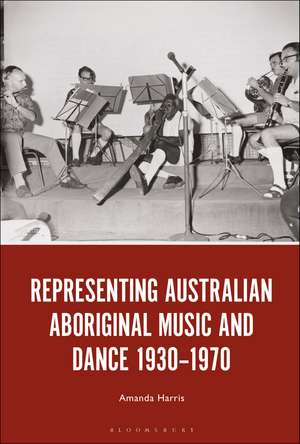Representing Australian Aboriginal Music and Dance 1930-1970
Autor Dr. Amanda Harrisen Limba Engleză Paperback – 26 ian 2022
| Toate formatele și edițiile | Preț | Express |
|---|---|---|
| Paperback (1) | 197.77 lei 6-8 săpt. | |
| Bloomsbury Publishing – 26 ian 2022 | 197.77 lei 6-8 săpt. | |
| Hardback (1) | 568.87 lei 6-8 săpt. | |
| Bloomsbury Publishing – 2 sep 2020 | 568.87 lei 6-8 săpt. |
Preț: 197.77 lei
Preț vechi: 257.87 lei
-23% Nou
Puncte Express: 297
Preț estimativ în valută:
37.84€ • 39.61$ • 31.50£
37.84€ • 39.61$ • 31.50£
Carte tipărită la comandă
Livrare economică 31 martie-14 aprilie
Preluare comenzi: 021 569.72.76
Specificații
ISBN-13: 9781501373831
ISBN-10: 1501373838
Pagini: 256
Dimensiuni: 152 x 229 mm
Greutate: 0.34 kg
Editura: Bloomsbury Publishing
Colecția Bloomsbury Academic
Locul publicării:New York, United States
ISBN-10: 1501373838
Pagini: 256
Dimensiuni: 152 x 229 mm
Greutate: 0.34 kg
Editura: Bloomsbury Publishing
Colecția Bloomsbury Academic
Locul publicării:New York, United States
Caracteristici
Interrogates the origins of Australian composition trends that have relied on representation of Aboriginal culture as a marker of Australian distinctiveness.
Notă biografică
Amanda Harris is a research fellow at Sydney Conservatorium of Music, at the University of Sydney, Australia, and Director of the Sydney Unit of digital archive PARADISEC. Her research focuses on gender, music and cross-cultural Australian histories. She is editor of Circulating Cultures: Exchanges of Australian Indigenous Music, Dance and Media (2014) and co-editor of Research, Records and Responsibility (2015) and Expeditionary Anthropology (2018).
Cuprins
List of FiguresNotes on ContributorsAcknowledgementsList of Abbreviations1. Staging Assimilation: Too Many John Antills?Prelude, Mungari Buldyan - Song for my Grandfather by Shannon Foster2. 1930s - Performing Cultures: Navigating Protection, Responding to Assimilation3. 1940s - Reclaiming an Indigenous Identity4. 1950s - Jubilee Celebrations, Protest and National Cultural InstitutionsInterlude by Tiriki Onus5. 1960-67 - Aboriginal Performance Takes the Main Stage6. 1967-1970 - The End of Assimilation?7. Disciplining Music: Too Many Peter Sculthorpes?Coda by Nardi SimpsonNotesBibliographyIndex
Recenzii
Harris is a great storyteller and researcher. She eloquently tells the hidden stories behind Australia's historical events through the lens of Aboriginal music and dance. In addition, she reveals the complex relations between the settler Australians and the Aboriginal people. studies presented in this book are not only essential for those interested in Aboriginal performance studies but also for history enthusiasts and general readers who want to learn about Australian history in a more comprehensive way.
A most thoughtful, compelling study . Harris writes with such empathy about all the diverse actors in these encounters.
Representing Australian Aboriginal Music and Dance is an exciting and original book. Harris offers a richly textured and expansive narrative of Aboriginal and Aboriginal-inspired music and dance across the country, interwoven with the history and politics of Indigenous rights in the twentieth century, and underpinned by a deep knowledge of Australian musicology. Through meticulous research, she has revealed unknown story after story of performances in which Aboriginal people emerge as historical individuals and assertive agents of profound social and political change. From the powerful opening 'Prelude' contributed by D'harawal scholar Shannon Foster, about her grandfather, the activist and songman Tom Foster, Harris's dialogic engagement with Aboriginal voices is respectful and unforced, and drives the book's underlying message to recognise our shared humanity. Representing Aboriginal Music and Dance is essential reading for those interested in twentieth-century Aboriginal history or Indigenous performance studies, but it will resonate with all who seek out histories that inspire as well as inform us.
The book makes an important contribution to the 'truth telling' of Australian history ... Harris has contributed significantly to understandings of this history and of the performance events that have shaped the development of Australian art music.
Harris's book offers an inclusive model of intercultural collaborative research that makes space for Indigenous voices and meaningful engagement with custodians. Brilliantly conceived and written, it is a major contribution to the fields of history, (ethno)musicology, Indigenous studies and performance studies.
A most thoughtful, compelling study . Harris writes with such empathy about all the diverse actors in these encounters.
Representing Australian Aboriginal Music and Dance is an exciting and original book. Harris offers a richly textured and expansive narrative of Aboriginal and Aboriginal-inspired music and dance across the country, interwoven with the history and politics of Indigenous rights in the twentieth century, and underpinned by a deep knowledge of Australian musicology. Through meticulous research, she has revealed unknown story after story of performances in which Aboriginal people emerge as historical individuals and assertive agents of profound social and political change. From the powerful opening 'Prelude' contributed by D'harawal scholar Shannon Foster, about her grandfather, the activist and songman Tom Foster, Harris's dialogic engagement with Aboriginal voices is respectful and unforced, and drives the book's underlying message to recognise our shared humanity. Representing Aboriginal Music and Dance is essential reading for those interested in twentieth-century Aboriginal history or Indigenous performance studies, but it will resonate with all who seek out histories that inspire as well as inform us.
The book makes an important contribution to the 'truth telling' of Australian history ... Harris has contributed significantly to understandings of this history and of the performance events that have shaped the development of Australian art music.
Harris's book offers an inclusive model of intercultural collaborative research that makes space for Indigenous voices and meaningful engagement with custodians. Brilliantly conceived and written, it is a major contribution to the fields of history, (ethno)musicology, Indigenous studies and performance studies.
